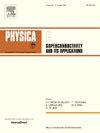Superconducting single crystals show about 50% increase of the superconducting critical temperature after Ar Ion implantation
IF 1
3区 物理与天体物理
Q4 PHYSICS, APPLIED
Physica C-superconductivity and Its Applications
Pub Date : 2025-05-08
DOI:10.1016/j.physc.2025.1354733
引用次数: 0
Abstract
Single crystals of a Fe-based superconductor, Ba(Fe0.943Co0.057)2As2, with ∼200 μm thickness (t) have been irradiated along the thickness (c-axis) of by 1.5 MeV Ar6+ ions, having ion range (R) of 0.903 μm (SRIM calculation). Fast ion irradiations damage the lattice of the target, and usually decrease the superconducting critical temperature (Tc), with a few exceptions of small increases. However, our irradiation, a case of ion implantation (R > t), presently to a fluence of 2.5 × 1015 Ar6+/cm2, increased the onset Tc of the single crystal superconductors by ∼ 8 K from its initial value of ∼ 17 K as measured from the real part of the magnetic susceptibility, matching results from our additional measurements of the imaginary part, electrical resistivity and magnetization. These self-supporting Tc results ensure correctness of the result. To our knowledge, such huge increase of the superconducting critical temperature by ion irradiation has not been reported earlier. Fortunately, we find following explanation, and consider it most appropriate. The insoluble inert gas atoms precipitate often as high-pressure miniature bubbles as is well known from various experiments and also from observations in nuclear reactor walls. This exerts a large compressive strain on the lattice. Our novel explanation is that this additional strain increases Tc by ∼ 49 %. Moreover, the same Ar implantation in non-superconducting BaFe2As2 induced 20 K superconductivity. Depending on such bubble formation and their stability in other target-ion pairs, such large Tc enhancement may be discovered in other superconductors, and used with the advantages of higher Tc.
氩离子注入后,超导单晶的超导临界温度提高了约50%
以厚度为~ 200 μm (t)的铁基超导体Ba(Fe0.943Co0.057)2As2单晶为材料,沿厚度(c轴)辐照1.5 MeV的Ar6+离子,离子范围(R)为0.903 μm (SRIM计算)。快速离子辐照会破坏靶材晶格,通常会降低超导临界温度(Tc),但也有少量升高。然而,我们的辐照,离子注入(R >;t),目前达到2.5 × 1015 Ar6+/cm2的影响,将单晶超导体的起始Tc从磁化率的实部测量的初始值~ 17 K增加了~ 8 K,与我们对虚部,电阻率和磁化率的附加测量结果相匹配。这些自支持的Tc结果保证了结果的正确性。据我们所知,离子辐照使超导临界温度如此大幅度的提高,以前还没有报道过。幸运的是,我们认为下面的解释是最合适的。不溶性惰性气体原子通常以高压微型气泡的形式析出,这一点从各种实验和在核反应堆壁上的观察中众所周知。这对晶格施加了很大的压缩应变。我们的新解释是,这种额外的应变使Tc增加了~ 49 %。此外,在非超导BaFe2As2中注入相同的Ar可诱导20k超导。根据这种气泡的形成及其在其他靶离子对中的稳定性,可以在其他超导体中发现如此大的Tc增强,并与更高Tc的优点一起使用。
本文章由计算机程序翻译,如有差异,请以英文原文为准。
求助全文
约1分钟内获得全文
求助全文
来源期刊
CiteScore
2.70
自引率
11.80%
发文量
102
审稿时长
66 days
期刊介绍:
Physica C (Superconductivity and its Applications) publishes peer-reviewed papers on novel developments in the field of superconductivity. Topics include discovery of new superconducting materials and elucidation of their mechanisms, physics of vortex matter, enhancement of critical properties of superconductors, identification of novel properties and processing methods that improve their performance and promote new routes to applications of superconductivity.
The main goal of the journal is to publish:
1. Papers that substantially increase the understanding of the fundamental aspects and mechanisms of superconductivity and vortex matter through theoretical and experimental methods.
2. Papers that report on novel physical properties and processing of materials that substantially enhance their critical performance.
3. Papers that promote new or improved routes to applications of superconductivity and/or superconducting materials, and proof-of-concept novel proto-type superconducting devices.
The editors of the journal will select papers that are well written and based on thorough research that provide truly novel insights.

 求助内容:
求助内容: 应助结果提醒方式:
应助结果提醒方式:


